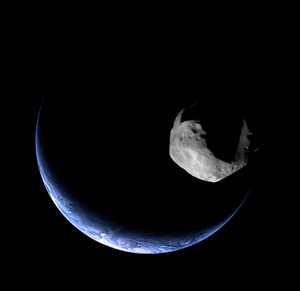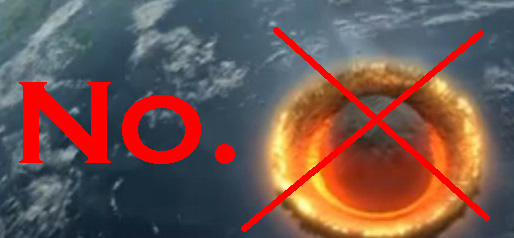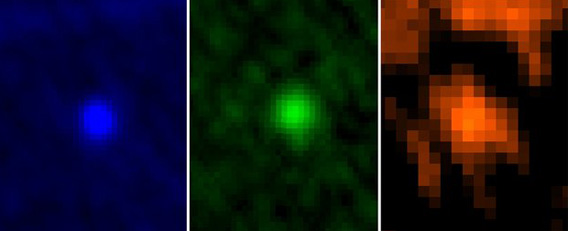Impact Threat from Near-Earth Asteroid Apophis in 2036 Now Ruled Out

Image credits: Earth: ESA/Rosetta; asteroid Mathilde: NASA/NEAR
Good news, everyone! New observations taken in the past few days have now ruled out an impact by the asteroid Apophis in 2036. Which is good, because it turns out to be even bigger than we thought.
Apophis is an asteroid that orbits the Sun on a path that brings it near the Earth every seven years or so. It was discovered in 2004, and was quickly found to be potentially hazardous: Its orbit crossed the Earth’s, meaning it could impact us. At a size originally estimated at 250 meters—bigger than a battleship—an impact would be huge: it would generate a blast energy of roughly a gigaton, or a billion tons of TNT exploding. That’s 20 times bigger than the largest nuclear weapon ever detonated on Earth.
So, yeah. It was taken seriously.
Swing and a Miss
We know it will make a very close shave of the Earth in April 2029, passing so low it will actually be under many of our satellites! While it will certainly miss on that date, there was a problem: The Earth’s gravity would bend the asteroid’s path, and if it passed us at just the right distance (through a region of space nicknamed the keyhole), it would move into an orbit that would cause an impact in April 2036, seven years later.
The problem was we didn’t know the trajectory of the asteroid well enough to say if there would be an impact or not. There simple weren’t enough accurate observations, so trying to predict where it would be more than two decades in the future introduced a fuzziness to its position. There was a small but significant chance it would pass through the keyhole in 2029, leading to a later impact.
Observations taken a couple of years ago nailed down the orbit better, and the odds dropped to about one in a million. Yay! But still, a better number would be zero.

And that’s where we are now. Apophis is currently making a pass of Earth (at a distance of 14 million kilometers, or 9 million miles), which is favorable for observing it. Astronomers used NASA’s Goldstone radar facility to send pulses of radar to the asteroid and back, which yield highly accurate positions for the rock. When the new data were added to what was already known about its orbit, it was found the asteroid will definitely miss the keyhole in 2029, and thus miss us in 2036. By a large margin, actually: more than 20 million kilometers (14 million miles), or 50 times the distance to the Moon. And that’s a minimum distance, so it looks like we’re safe from this rock.
Yay!
Bigger Is Not Better
And there’s bigger news. Literally. New observations by Herschel, an orbiting infrared telescope, show Apophis was bigger than originally estimated. Instead of 270 meters across, it’s actually more like 325 meters (1065 feet)! That may not seem like much, but remember, this is diameter we’re talking. The mass of an object goes up as the cube of the diameter (double the size of a sphere and you have eight times the volume, and eight times the mass). This additional 20 percent increase in width means it’s 75 percent more massive. An impact would therefore be that much more devastating.
The reason the size isn’t well known is because it’s an unresolved dot in telescopes. You can’t just take a picture and measure how big it is. Instead, you estimate the size by measuring how bright it is and knowing how far away it is. Most asteroids reflect roughly 4 percent of the light hitting them, so you can put all that information together to get a size—a bigger rock would be brighter at a given distance, for example.

Image credit: ESA/Herschel/PACS/MACH-11/MPE/B.Altieri (ESAC) and C. Kiss (Konkoly Observatory)
The problem is in that reflectivity number. It’s a bit of a guess. But the new Herschel observations nail it down. By looking at Apophis in different wavelengths (essentially colors) of infrared light, it was found that the surface of the asteroid is darker in visible light than first thought. If it’s darker, than it must be bigger to be as bright as it is. And that means a bigger impact... so it's good thing it'll miss!
Now What?
Let me be clear: This is all really good news. It’s great that Apophis will definitely miss, and very cool that we got better measurements of its size (and this comes on the heels of news of another asteroid, 2011 AG5, that was initially thought to have a shot at hitting us in 2040, but we now know will make a clean miss). But the lessons of Apophis are two-fold. They are that 1) we’re getting better at looking for, finding, and tracking asteroids, and b) we need to be taking this threat very seriously.
An impact by an Apophis-sized object would be catastrophic. It would utterly destroy everything within hundreds of kilometers of the impact site, and the effects would be felt across the planet. It wouldn’t be an extinction-level event like the one that wiped out the dinosaurs, but it wouldn’t be a stroll in the park, either. And not to put too fine a point on it, think of it this way: Two airplanes crashed into buildings brought the global economy to its knees. What would a gigaton impact do?
Perhaps more than even Hollywood has done, Apophis brought this danger to the public's attention. Astronomers, though, have been serious about this for years. The B612 Foundation was created by scientists, engineers, and astronauts specifically to locate, identify, and possibly prevent asteroids from hitting the Earth—they have a program to build a space mission called Sentinel to track potentially hazardous asteroids. At JPL, scientists are looking into building a similar mission called NEOCam.
I support both these missions! We also need more ground-based facilities watching out as well. We simply cannot have too many eyes on the sky. We have the technology to actually prevent big impacts from occurring, and all we have to do is make the choice to do so. If we do nothing, given enough time, an impact will occur. There is no doubt about that. None at all.
I commonly and loudly proclaim how wonderful science is, and astronomy in particular. But in this case, they can literally save the world.
[UPDATE: After I posted this article, BA Bloggee @scottder on Twitter put together the following picture, which made me very happy. You may need to read up on the "Grumpy Cat" meme to uinderstand it fully.]


